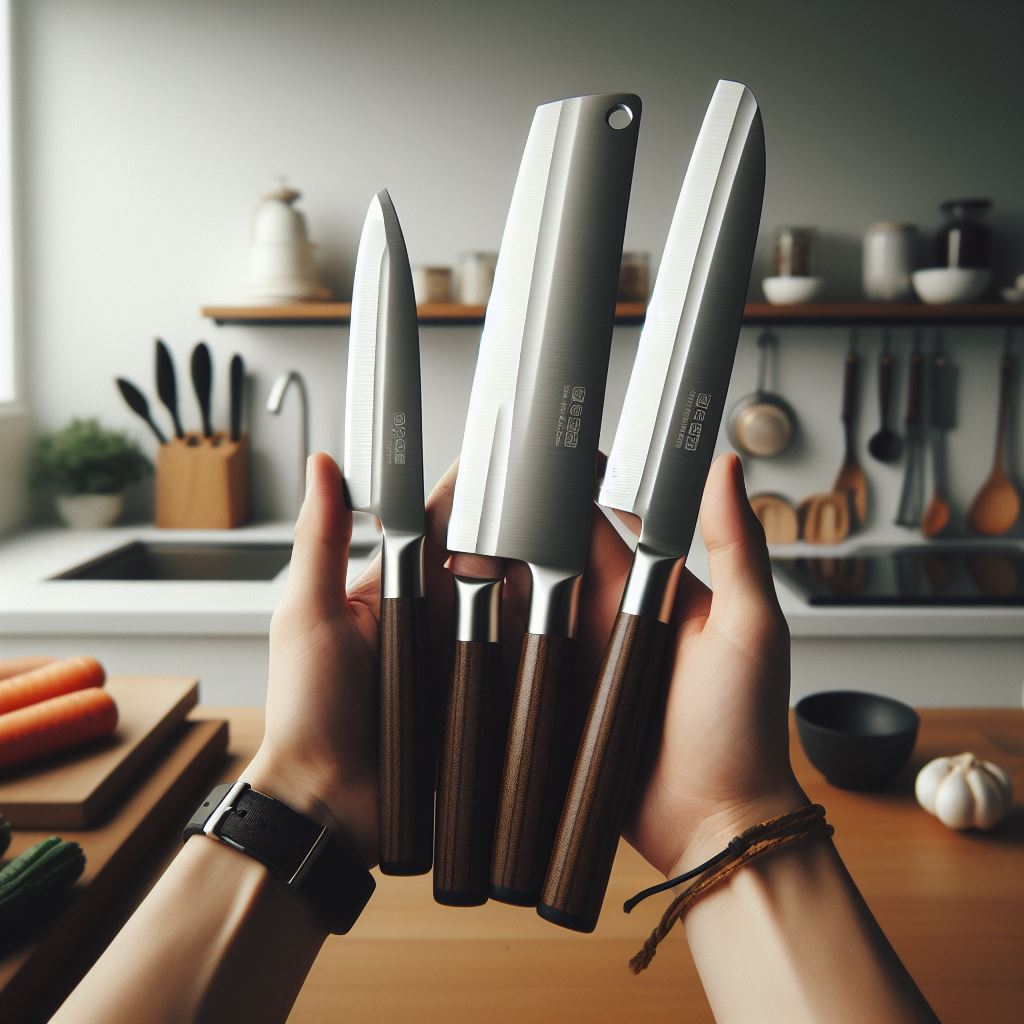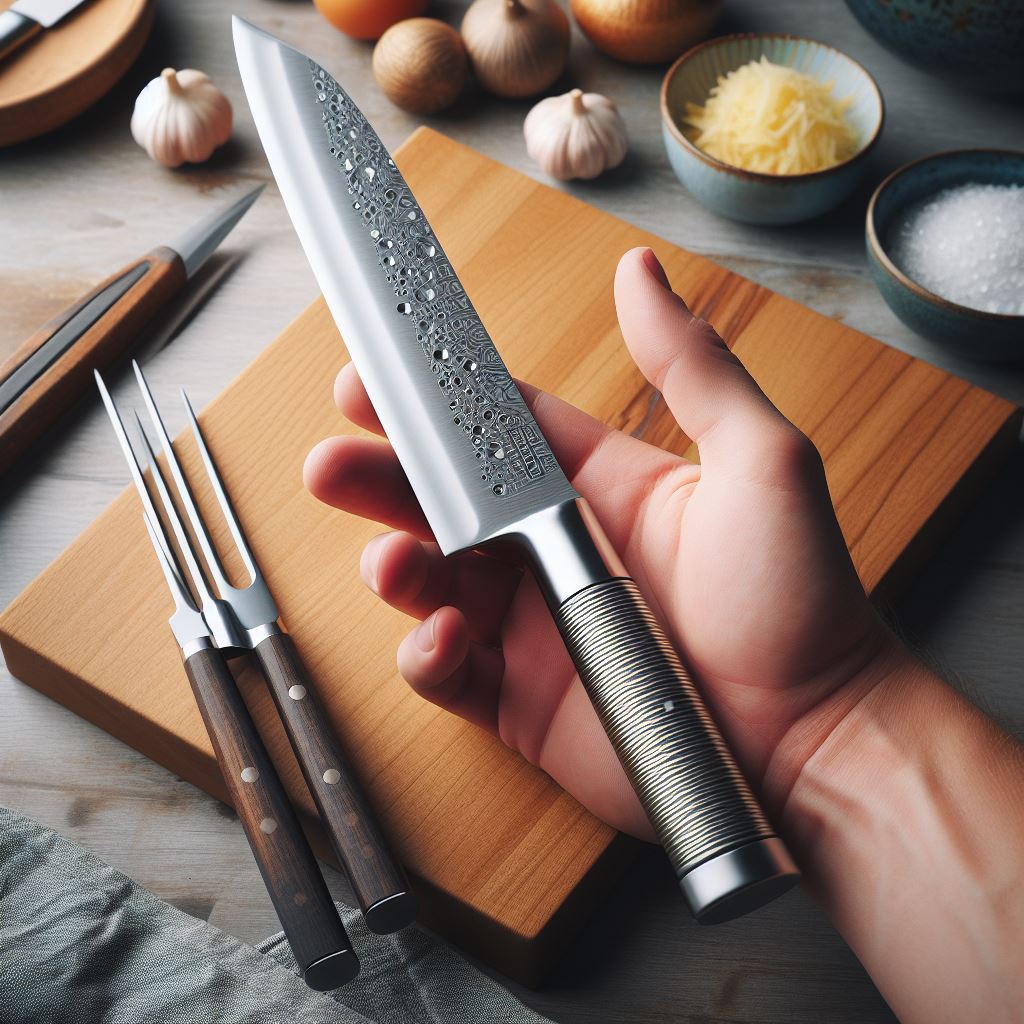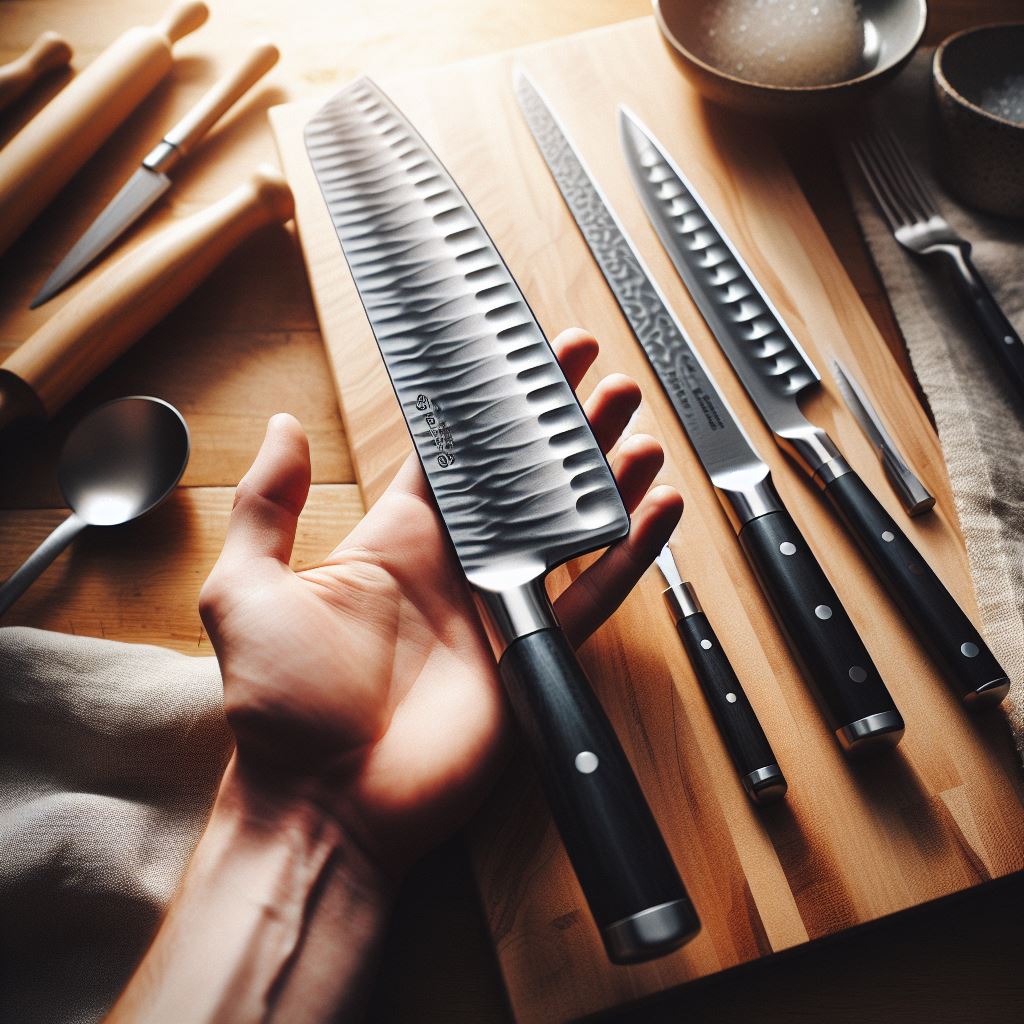Santoku knives are versatile kitchen tools designed for slicing, dicing, and chopping. Their unique shape allows for efficient cutting of vegetables, meat, and fish.
Crafted to enhance the culinary experience, santoku knives originate from Japan, boasting a distinctive design that merges the best of a chef’s knife with a cleaver. The name ‘santoku’ translates to ‘three virtues,’ aptly reflecting its prowess in handling the three fundamental tasks in food preparation.
With their sharp, flat edges and sheepsfoot blade that curves down to meet the tip, santoku knives offer clean cuts without the need for rocking motions, unlike traditional Western chef knives. Their popularity has soared globally due to their lightweight nature and ergonomic handles that make lengthy food prep sessions less taxing on the hands, allowing chefs and home cooks alike to create perfect dishes with precision and ease.

The Santoku Knife: An Introduction
Unveiling the quintessence of Japanese culinary craftsmanship, the Santoku knife stands as a testament to both tradition and innovation in the kitchen. Beloved by professional chefs and home cooking enthusiasts alike, this multi-purpose blade offers precision and versatility that far exceed ordinary expectations. From slicing delicate fish to chopping hearty vegetables, the Santoku knife promises a sublime cutting experience tailored for a wide range of food preparation tasks.
Origins And Meaning Of Santoku
Embarking on a historical journey, the Santoku knife reveals roots deep within Japanese culture. “Santoku” translates to “three virtues” or “three uses”, encapsulating its adeptness at slicing, dicing, and mincing. A marvel of the gastronomic world, its origin story begins in the mid-20th century as a harmonious blend of Japanese and Western culinary tools, aiming to cater to the evolving needs of modern home cooks.
Characteristics Of A Santoku Knife
Recognizing a Santoku knife involves noting the following distinctive features:
- Blade Length: Typically ranging from 13 to 20 centimeters (5 to 8 inches), providing ample space for a variety of cutting tasks.
- Blade Shape: A flat edge with a gently curving spine, culminating in a sheep’s foot tip that enhances control.
- Bevel: Most often featuring a double bevel, ground on both sides of the blade, optimized for precision.
- Construction: Crafted using high-quality steel or ceramic for extreme sharpness and enduring performance.
- Handle: Ergonomically designed to fit comfortably in hand, ensuring safety and ease during repetitive motion.
Comparing Santoku To Other Kitchen Knives
Distinguishing the Santoku knife from its kitchen counterparts involves examining its unique qualities against other types of knives:
| Knife Type | Primary Use | Blade Length | Blade Shape |
|---|---|---|---|
| Santoku Knife | General-purpose; excels at slicing, dicing, and mincing | 13-20 cm | Flat edge, sheep’s foot tip |
| Chef’s Knife | Versatile; designed for slicing, chopping, and mincing | 15-35 cm | Curved edge, pointed tip |
| Utility Knife | General-purpose; ideal for smaller tasks | 10-18 cm | Narrow, pointed tip |
Through this analysis, it becomes apparent that each knife fulfills specific roles in the kitchen. The Santoku’s shorter, balanced blade offers a different experience compared to the longer, more versatile chef’s knife, while the utility knife serves handily for more delicate or precision tasks. Embracing these distinctions allows one to select the ideal knife for the task at hand, ensuring efficiency and enjoyment during food preparation.
Versatile Uses Of Santoku Knives In The Kitchen
The Santoku knife, a culinary maestro from Japan, is a staple in both professional and home kitchens worldwide. With its unique design and sharp edge, it undertakes a variety of tasks, making it a true all-rounder. Chefs and cooking enthusiasts cherish the Santoku for its ease of use and multipurpose functionality. This versatility is exactly what drives the popularity of these knives.
Mastering The ‘three Virtues’: Slicing, Dicing, And Mincing
The name ‘Santoku’ itself hints at the three cutting tasks it performs best: slicing, dicing, and mincing. With a Santoku knife in hand, cooks can glide through the cutting board with less effort and more precision. Its broad blade is excellent for slicing delicate fruits and giving clean cuts. For dicing vegetables or herbs, the Santoku proves exceptional due to its thin and sharp edge that minimizes cell damage, preserving the freshness and appearance. When it comes to mincing, the knife’s ergonomic design allows for rapid chopping action without causing fatigue.
Precision Cuts: The Santoku’s Advantage With Vegetables
Santoku knives shine when it comes to working with vegetables. Thanks to their thinner and sharper blades, they achieve precision cuts that retain the visual appeal and texture of vegetables. Whether creating paper-thin slices of tomato or finely chopping onions, the Santoku’s precision is unrivaled. Its granton edge—hollowed-out grooves along the side—also helps prevent food from sticking to the blade, making swift and clean work of any vegetable prepping task.
Handling Meats And Fish With A Santoku Knife
Santoku knives are not limited to plant-based ingredients; they are also perfect for meat and fish. The sharpness and balance of the Santoku allow for smooth cuts through meat, whether you’re slicing chicken breasts or portioning steaks. And when it comes to fish, the Santoku’s flawless cutting action ensures delicate textures are maintained, whether fileting a fish or cutting sushi ingredients.
Beyond Chopping: Alternative Uses For A Santoku
While the Santoku is primarily known for chopping, its uses extend beyond. The flat blade can be used for crushing garlic or flattening chicken breasts, while the wide blade can scoop up ingredients and transfer them from the cutting board to the pan. The Santoku can even take on tasks like peeling and trimming when the user has full control over the blade, utilizing the precise tip for delicate work by employing the ‘pinch grip’ technique.

Maintaining Your Santoku Knife
Maintaining your Santoku knife is vital to preserving its precision and effectiveness in the kitchen. A Santoku knife is a versatile Japanese blade, renowned for its ability to slice, dice, and chop with unparalleled ease. To ensure your Santoku remains a culinary companion for years to come, follow these crucial care techniques.
Proper Cleaning Practices For Longevity
After using your Santoku knife, it’s essential to clean it promptly and properly. Wash the blade by hand with mild soap and warm water, carefully cleaning both sides of the blade to remove any food particles. Avoid using harsh detergents or scrubbers that can scratch the surface. Rinse thoroughly and dry the knife immediately with a soft cloth to prevent rusting. Proper cleaning prevents buildup that can dull the knife and ensures its longevity.
The Art Of Sharpening A Santoku Blade
Sharpening a Santoku knife is an art that combines precision and care. Use a whetstone or a ceramic sharpener designed specifically for Santoku blades. Begin with a coarse grit to reshape the edge if it’s very dull, then proceed to a fine grit for finishing. Soak your whetstone in water before use, and keep the blade at a 15-degree angle to the stone. Smooth, consistent strokes across the stone sharpen the blade effectively without removing too much metal. Regular sharpening maintains the keen edge necessary for perfect cuts.
Storage Solutions To Protect Your Knife
Storing your Santoku knife correctly is just as important as the cutting tasks it performs. Avoid tossing it in a drawer, as this can cause the blade to become dull and pose a safety hazard. Instead, opt for a knife block, magnetic knife strip, or a protective blade sheath. These storage solutions safeguard the blade from damage and keep your fingers safe. Remember, a well-protected knife is a lasting tool in your culinary arsenal.

Choosing The Right Santoku Knife For Your Needs
Embarking on the quest to find the perfect Santoku knife can be as thrilling as it is daunting. The Santoku, a Japanese culinary marvel, is a proficient and versatile chef’s tool, adept at slicing, dicing, and mincing with precision. But to harness its full potential, selecting the right one for your kitchen arsenal is pivotal. Crafted to address a plethora of cooking tasks, the right Santoku knife is a game-changer for chefs and home cooks alike.
Essential Features To Consider When Buying A Santoku Knife
Material Quality: A Santoku knife’s performance is heavily dictated by the material of its blade. High-carbon stainless steel is a popular choice, providing exceptional sharpness and edge retention.
Handle Comfort: The handle should feel balanced and comfortable in your hand, made from durable materials such as wood, plastic, or composite.
Blade Design: Look for a blade with a slight curve to facilitate a rocking motion and hollow edges to prevent food from sticking.
Weight and Balance: Opt for a knife that feels balanced; a well-distributed weight allows for better control and less fatigue.
Maintenance: Consider how much time you are willing to invest in care. Some blades require regular sharpening and proper storage to maintain their edge.
High-end Brands Vs. Budget-friendly Options
- High-End Brands: Brands like Shun, Miyabi, and Global offer top-tier Santoku knives with exceptional craftsmanship and materials. These are ideal for those seeking the pinnacle of performance and durability.
- Budget-Friendly Options: More affordable brands such as Victorinox and Mercer offer reliable quality at a more accessible price point. Perfect for everyday use without sacrificing too much in terms of functionality.
Size Matters: What Blade Length Is Best For You?
The blade length of a Santoku knife typically ranges from 5 to 7 inches. Selecting the right size should be based on your comfort and the tasks you perform most frequently:
5-6 inches: Ideal for smaller hands and more detailed work where precision is key.
6-7 inches: The most versatile size, suitable for a broad range of kitchen tasks, and perfect for those with medium-sized hands.
Choosing a Santoku knife demands consideration of how it complements your culinary style. Material, brand, and blade length are all essential factors that will guide you to the right selection, ultimately elevating your cooking experience.

Mastering Santoku Knife Techniques
Each kitchen tool has its secrets, and the Santoku knife is no exception. Brought to prominence from the heart of Japan, the Santoku knife exemplifies versatility in the kitchen. Becoming adept with this knife can elevate your culinary skills to a new level. It’s not just any knife; it’s a reflection of meticulous craftsmanship and cultural heritage. Mastering Santoku knife techniques demands understanding its design and strengths which are anchored in precision cutting, slicing, and mincing.
Fundamental Cutting Techniques Suitable For Santoku Knives
Santoku knives are renowned for their distinctive shape and balance, which promote a variety of fundamental cutting techniques. These knives require less force and employ a more rhythmic chopping motion. Here are a few techniques suited for the Santoku:
- Slicing: Use a smooth, gliding motion, moving the knife forward and down.
- Chopping: Lift the knife and bring it down in a straight, swift motion for fast and effective chopping.
- Mincing: Rock the blade back and forth with the tip touching the cutting board for a fine cut.
Advanced Skills: Tips From Professional Chefs
Aspiring to professional chef levels of proficiency? Integrate these tips into your culinary repertoire:
- Maintain a sharp edge on your Santoku to enhance precision.
- Develop a consistent cutting rhythm suited to Santoku’s unique blade geometry.
- Utilize the full blade length by cutting with a fluid forward and downward motion, letting the knife do more of the work.
Perfection comes not just from knowledge, but from practice. Trust in the efficiency of your Santoku and your skills will surely advance.
Common Mistakes To Avoid With Your Santoku Knife
Even with a tool as forgiving as the Santoku, mistakes can occur. Avoid these common pitfalls to keep your knife (and your fingers) in top condition:
| Mistake | Impact | Corrective Measure |
|---|---|---|
| Using a glass or stone cutting board | Dulls the blade | Switch to a wood or plastic cutting board |
| Twisting the blade | Can cause chipping | Focus on straight down cuts |
| Incorrect storage | Potential for damage and dulling | Store in a knife block or sheath |
By incorporating these techniques and avoiding these errors, your Santoku knife will become an extension of your arm, capable of performing a wide range of culinary tasks with precision and grace.

Conclusion
Santoku knives have carved out a niche in the culinary world. Their versatility shines in slicing, dicing, and mincing tasks, proving indispensable to home chefs and professionals alike. Embrace the precision and finesse that a Santoku knife offers in your kitchen repertoire.
Remember, for those who value meticulous cuts and a multi-purpose tool, the Santoku knife is a supreme choice.
Frequently Asked Questions Of What Are Santoku Knives Used For
What Is A Santoku Knife?
A Santoku knife is a versatile Japanese kitchen knife. It features a flat edge and a sheepsfoot blade that curves in an angle approaching 60 degrees at the point. This design makes it excellent for slicing, dicing, and mincing.
What Makes Santoku Knives Special?
Santoku knives are valued for their multi-purpose use. The balance and weight make them easy to handle. Their sharp, straight edges allow for precise cuts without the need for rocking, as with some other knives.
Can Santoku Knives Chop Bones?
Santoku knives are not designed to chop bones. They’re crafted with thinner, more delicate blades ideal for precise cutting of fish, meat, and vegetables, but not for hard materials like bones.
How Does A Santoku Differ From A Chef’s Knife?
A Santoku is typically shorter and has a flatter blade profile compared to a chef’s knife, which usually has a curved edge that allows for a rocking motion. Santokus often have a thinner blade, making them excellent for fine cuts.






